Claybury Hospital
Manor Road, Woodford Bridge, Essex IG8 8BY
Medical dates:
Medical character:
Mental
In the 1880s the Justices of the County of Middlesex planned to build a fourth County Asylum to relieve overcrowding in the Hanwell, Friern Barnet and Banstead
Asylums. The Claybury Hall estate at Woodford Bridge, Essex, was
purchased in January 1887 as the site for the new asylum at a cost
of £36,000. Other lands bordering the estate were also
bought, and the total cost of the 269-acre site was £39,415.
Claybury Hall was situated on the top of Tomswood Hill and its grounds included about 50 acres of ancient woodland and 95 acres of open parkland, ponds, pasture and historic gardens which had been designed in 1789 by the landscape architect Sir Humphrey Repton.
An architectural design competition was held, and won by George Thomas Hine, the acknowledged leading asylum architect in the country. His plan - a pioneering 'compact arrow design' - laid out the asylum in a smaller and more logical layout than previously used.
In March 1888 a granite-railed tramway was laid from the gate lodges (under construction) to the main site so that building work could begin in June. Two-thirds of the main buildings were to be erected on the summit of the hill but, first, some 100,000 cubic yards had to be sliced off to create a level platform of 12 acres. This took six months to do and, unfortunately, it then proved difficult to find firm foundations in the spongy subsoil. Building work then stopped altogether in December 1888 when the main contractor became bankrupt.
However, another contractor working on the entrance lodges had completed them by the end of January 1889, at the cost of £2,464.
To complicate matters, following the Local Government Act of 1888, the construction of the asylum was handed over to the newly formed London County Council (LCC). The Council decided to continue with the project, now to become the Fifth County of London Asylum (the LCC also inherited Cane Hill Asylum, as well as the Hanwell, Friern Barnet and Banstead Asylums).
Building work began again under a new contractor in February 1889. On 12th June 1890 Lord Rosebery laid a suitably inscribed stone over the main entrance to the Asylum.
Six months after starting work the 700 navvies and labourers went on strike, demanding 6d (2.5p) an hour instead of five pence halfpenny (2.3p) for navvies and five pence three farthings (2.4p) for labourers. After two weeks the contractor agreed and work resumed.
The original Claybury Hall, built in 1785, had originally contained 19 bedrooms and dressing rooms, a boudoir, dining and drawing rooms, a library, billiard and morning rooms, a conservatory, an entrance hall, domestic offices and cellarage. It was repaired and converted into a private asylum at a cost of £800 and a new wing added for £13,130. It could accommodate about 50 patients, who were charged 30 shillings (£1.50) a week if from London, or 40 shillings (£2) if not.
By April 1892, the date named for completion, the buildings were roofed in, the interior walls plastered and the floor laid, but it would be another year before patients could be admitted.
The construction of the Asylum was finished in 1893. It had 2,000 beds and the first patients were admitted on 16th May that year. From May 1893 until February 1894 some 1,130 patients were transferred from 40 different asylums and Licensed Houses. The remaining 860 were acute cases admitted as they occurred in London (where people were certified insane at a rate of 70 a week).
The design of the Asylum, as carried out under the direction of the Justices of the County of Middlesex, had been lavish and to a high specification. While the ward blocks were relatively plain, the 'public' buildings had stained glass windows and detailed ceilings. The Asylum Committee of the LCC did not share this enthusiasm for erecting huge palatial buildings for the insane, and the rest of its asylums were designed to a humbler specification.
The Asylum was built to accommodate 800 male and 1,200 female pauper lunatics, and had over 20 acres of floor space. The sexes were strictly segregated. On admission, each patient was examined and photographed. Male patients were issued with three suits of clothing - two for everyday working wear, that is, one for summer and one for winter, and one for Sundays - as well as an Inverness overcoat. The women had no specific uniform.
The male and female sides each contained three 2-storey ward blocks for sick and infirm and recent cases. These six blocks accommodated 650 patients (300 male and 350 female) in 12 distinct wards, each self-contained on one floor.
The 2-storey blocks were connected by 1-storey corridors, which also communicated with the Administration building, the Recreation Hall and chapel. The corridors were 15 feet (4.5 metres) wide and divided by screens. They were cross-ventilated and heated so they could be used by patients for exercise in bad weather. One section of the corridors of the male and female wings was used as a visiting room three times a week.
In addition, there were two 3-storey blocks for acute cases, with 6 wards for 180 patients on the male side and 9 wards for 295 patients on the female side. Each ward contained 21 or 30 beds, but was subdivided into 3 or 4 separate rooms.
The bedsteads in the wards were of iron with rubber pads to their feet instead of castors, to prevent rolling and scratching of the polished pitch-pine floor. Instead of rods and bars the bed heads were of one piece of sheet iron (so that there was no convenient place to tie a sheet for suicide attempts). The tinned wire-woven mattresses were filled with horsehair and weighed 20 lbs each.
The Day Rooms were furnished with settees and armchairs upholstered in carpet or leather. The arms of the armchairs were padded to prevent sores developing in paralysed or immobile patients. The sofas had no sides and were covered in green American leather. Also available were ordinary chairs and Austrian bentwood chairs. Each of the 2,000 patients was theoretically supplied with four chairs (excluding soft seating) - one each in the dining, sitting and bedrooms and in the Recreation Hall.
All the floors were beeswaxed and therefore needed no wet scrubbing.
The two large airing courts were enclosed by unclimbable iron fencing. The paths were asphalted. The courts contained ordinary garden seating and, in bad weather, seats were available in kiosks.
Near the centre, fronting the two courts, were two blocks of 3 wards each for epileptics (170 males and 190 females), with dormitories on the first floor. Behind these wards were 3-storey blocks for quiet working and chronic cases (350 males and 460 females), with Day Rooms on the ground floor and dormitories above.
A block for 150 female patients employed in washing was located near the laundry.
The Asylum had 36 padded rooms (all of India rubber), 20 of which were fully padded and the rest 'half-padded'.
An isolation hospital with 20 beds lay 100 yards to the north of the Asylum, and a small ward of 2-3 patients was kept always available in case of an outbreak of infection.
Adjacent to the cross-corridors and near the general wards were the bathrooms and dressing rooms - 24 on the male side and 36 on the female.
The site included workshops and a large, splendid Recreation Hall, which was 120 ft x 60 ft (36 metres x 18 metres) wide and could seat 1,000 persons. The Hall had a stage for theatrical performances and regular entertainments - concerts and plays - were provided for the patients. The chapel could seat 800.
The Administrative Departments lay between two service corridors, which ran from north to south and were 12 feet (3.6 metres) wide. There was separate access from the male and female sides to the laundry building, stores, kitchens, offices and Recreation Hall.
Two blocks were for attendants and nurses, with Day, Mess and Club rooms on the ground floor and bedrooms on the floors above. A separate wing for night nurses was located on the north side of the Asylum.
On the eastern side of the chapel lay the Medical Superintendent's house, which was connected to the Asylum by a private covered corridor. There was also a detached house for the Steward.
The Mortuary contained two rooms for the dead (one male, one female) and separate examination and specimen rooms. A cold room ensured bodies were kept below freezing point. The Mortuary and the farm buildings, including stabling for 6 horses, were built by the Works Department of the LCC at a cost of £14,200. The Asylum's farm (see below) was stocked with 80 cows and 400 pigs.
Whilst the roads and the outside of some of the buildings were lit by gaslight, the Asylum itself was lit by electricity. The cost of installing electricity had been estimated at £17,500, but in reality had been £23,000. (The Asylum generated its own electricity until July 1929, when a changeover to the Ilford Council supply was made. The generating room then became a gymnasium.)
In 1895, at a cost of £4,000, Sir Frederick Mott established a Pathology Laboratory at the Asylum to investigate the pathology of mental illness (the Asylum was one of the first to incorporate such a laboratory). The Mott Laboratory became internationally respected for neuropathological research (in 1916 it transferred to the Maudsley Hospital).
By 1896 the Asylum had reached a total capacity of 2,500 patients. Dr Robert Jones (1857-1943), the Medical Superintendent, calculated that the total cost of the Asylum had been £576,303. This sum, divided by 2,500, made the cost per bed to be £238 18s (£238.90).
In 1904, following the success of radium in the treatment of various disorders, Dr Jones began to treat melancholic patients with thorium. Thorium, a radioactive substance, was believed to be a million times less active than radium and did not have the latter's burning and destructive properties. A specially devised cap was made and 500 cc of thorium hydroxide, a heavy white powder, was placed between its quilted seams. It was then worn day and night. The first patient to be treated was an unpromising specimen with increased knee reflexes, pupils inactive to light and 'defective habits' common to the onset of dementia. He was finally discharged as recovered, but very loathe to leave behind the cap to which he attributed his recovery. Follow-up of the patient proved satisfactory. Dr Jones also employed the fluid extract of ergot as a treatment for his insane patients.
By 1909 the Asylum had 2,600 patient who were cared for by 400 male and female nurses. The Asylum was regarded as one of the most modern and up-to-date institutions for the care of the insane. Restraint was not practised, and the medical staff were reluctant to employ excessive drugs. Drugs were mainly given to promote sleep, as many new admissions were acutely maniacal and suicidal. Sulphonal was only prescribed for chronic, noisy and incurable patients. Seclusion, that is, locking a patient in a room for up to an hour in the daytime (7 a.m. to 7 p.m.), was used extremely rarely.
In 1913 Dr Jones prefixed 'Armstrong' to his name to distinguish himself from the orthopaedic surgeon, Robert Jones.
During WW1, in June 1915, some 252 patients were transferred from Horton Asylum, which had become the Horton (County of London) War Hospital. Claybury then had 2,739 patients. During the war the medical staff noted that, since the war had broken out, there had been less insanity, except for a number of patients suffering from fright and shock because of the Zeppelin raids. After a period of rest and reassurance, these patients recovered.
By 1920 the Asylum contained 1,068 male and 1,477 female patients. There were 245 female nurses and a large number of male nurses, as well as other staff. The huge kitchens, with their vast equipment, catered for some 2,800 people daily.
Patients with some hope of recovery were segregated from those with chronic disease. Their initial treatment was rest and an abundance of fresh air. Newcomers were kept in bed for several days in a ward with an open verandah.
In 1925 a wireless system was installed in many of the wards.
In 1927 the Asylum became affiliated to the London Hospital.
A new annexe with 50 beds, named Forest House, opened in 1929. Its wards, dining rooms and recreation rooms were painted in a colour scheme of brown and blue.
Following the Mental Treatment Act, 1930, which expunged the term 'Asylum' from official use, the Asylum was renamed Claybury Mental Hospital. The commemorative stone over the main entrance was recut to read 'Claybury Mental Hospital' instead of 'Claybury Lunatic Asylum'. The Act also outlawed the pejorative terms of 'lunatic', now a 'person of unsound mind', while a pauper became a 'rate-aided patient'. Mental patients could be admitted as voluntary or temporary patients without the stigma of being certified. However, 72 hours notice had to be given in writing before a voluntary patient could discharge him/herself.
By this time the Hospital had become world renowned for the treatment of mental disease. Experienced visitors came from as far away as the United States and Japan to observe patient care and treatment.
During the 1930s the Hospital underwent a period of expansion, the first time it had been necessary since the development of the Horton estate in Epsom. In 1930 a new Nurses' Home was built to accommodate 73 nurses. A new operating theatre was installed. In 1931 a Central Receiving wireless station was installed in the Recreation Hall and loud speakers connected to 20 wards. In addition, 200 headphones were bought for bed cases. The cost of the system had been £847. In 1937 a single-storey Admissions Villa - Orchard House - was built to accommodate 25 male patients and 20 convalescent patients.
After the expansion, as well as its own electrical substation, the Hospital had its own bank and Post Office.
During WW2 the Hospital joined the Emergency Medical Service (EMS). Four wards - some 570 of its 2,417 beds - were given over to the EMS for wounded servicemen. Most of the patients in Claybury Hall were moved to a ward so that the building could be used for nurse accommodation. (The combination of in-patients and medical and nursing staff meant that about 3,500 people were living on-site.) The operating theatre which had been installed in the 1930s proved inadequate for general surgery, so part of the Hospital building adjacent to the wards was converted into a general hospital-style operating suite. A lift - the first in the Hospital - was installed so that the operating theatre would be accessible to theatre trolleys.
During the war two V-2 rockets landed in the Hospital grounds, but there was little damage from High Explosive bombs, incendiary bombs causing more problems.
The Emergency War Hospital departed in January 1946 and, in 1948, the Hospital joined the NHS under the control of the Claybury Mental Hospital Management Committee, part of the North East Metropolitan Regional Health Board. It had 2,304 beds.
In 1954 a new treatment was introduced - the 'therapeutic community'. This year also saw the end of preparation of potatoes by the patients on the wards (the potatoes had to be finished by hand after being put through a crude peeling machine). By this time the Hospital population was ageing, some 34% of the patients being over 65 years.
The Mental Health Act, 1959 required that the word 'mental' be omitted from hospital names to emphasize that patients were on an equal footing regardless of what kind of hospital they were in. Thus, Claybury Mental Hospital became Claybury Hospital.
In the early 1960s the floors were covered with linoleum, thereby ending the era of floor waxing.
The 1960s also saw the development of a Psychology Department.
In March 1964 the top floor and roof of Claybury Hall were destroyed by fire.
In 1964 a Social and Recreation Centre opened in a purpose-built building. It contained a foyer, a shop, a tea room, a music room, a quiet room and a small recreation hall.
In June 1967 the stage area of the Recreation Hall was destroyed by fire and, in July, a large part of one ward, in which one patient died.
By 1970 the Hospital had 1,713 beds. The patient population had declined by over 1,000 since the mid 1950s and the Hospital had moved towards mixed-sex wards.
In 1974, following a major reorganisation of the NHS, the Hospital came under the control of the West Roding District Health Authority, part of the North East Thames Regional Health Authority. Facilities for the nursing staff had been greatly improved, but the condition of the main ward buildings had begun to deteriorate. Some 48% of the patient population were aged over 65 years.
In September 1976 Thorpe Coombe Hospital, a former maternity hospital five miles away from Claybury, became its annexe - a Mental Health Unit with 63 beds and a Day Hospital for elderly patients with mental illness.
By 1980 the Hospital had 1,245 beds. Some 55% of the patients were aged over 65 years.
In 1982 there was another NHS reorganisation, after which the Hospital came under the administration of the Waltham Forest Health Authority. It had 1,205 beds.
In 1985 some 42 acres of ancient woodland were leased to the London Wildlife Trust.
By the mid 1980s, with the introduction of Care in the Community and a consequent decline in patient numbers, the Hospital faced an uncertain future. The NHS had determined on its closure and of Friern Hospital, with laundry services being shut on both sites (the Claybury laundry closed on 18th March 1988).
On 1st April 1992 Waltham Forest Health Authority became the Forest Healthcare (NHS) Trust. By this time the main services of the wards were concentrated to the south of the Hospital, while the ward blocks to the north lay empty.
The Hospital finally closed in 1997.
The Tomswood Rehabitation Unit, originally sited at the Hospital, was relocated at a series of temporary sites before ending up at Whipps Cross Hospital in 1999. It had been planned to move the service to Hawkwell Court (which had accommodated a number of former Claybury patients) soon after 2007, but the move does not appear to have happened yet.
Present status (March 2008)
The main buildings are Grade II listed and have been retained. The isolation hospital and ward blocks at the north of the site, the laundry building, workers' residences and the farm buildings have been demolished.
The site was redeveloped by Crest Nicolson. The buildings were restored over three years and the site is now Repton Park, a gated community and business park only accessed by Clarence Gate, to the northwest of the site. Some of the former ward blocks have been converted into luxury apartments, and new housing has been built in the grounds. Claybury Hall, which had become the Headquarters of the Waltham Forest Health Authority, has also been restored and converted into apartments.
The chapel is now a swimming pool and the Recreation Hall a gym and leisure centre. The water tower has been converted into a private residence spread over eight floors.
Many mature trees survive.
Parts of the Hospital grounds have become Claybury Park, a new public park of some 104 acres belonging to the London Borough of Redbridge. It contains a wide variety of spaces, from formal parkland to ancient woodland, grassland and wetlands.
Claybury Hall was situated on the top of Tomswood Hill and its grounds included about 50 acres of ancient woodland and 95 acres of open parkland, ponds, pasture and historic gardens which had been designed in 1789 by the landscape architect Sir Humphrey Repton.
An architectural design competition was held, and won by George Thomas Hine, the acknowledged leading asylum architect in the country. His plan - a pioneering 'compact arrow design' - laid out the asylum in a smaller and more logical layout than previously used.
In March 1888 a granite-railed tramway was laid from the gate lodges (under construction) to the main site so that building work could begin in June. Two-thirds of the main buildings were to be erected on the summit of the hill but, first, some 100,000 cubic yards had to be sliced off to create a level platform of 12 acres. This took six months to do and, unfortunately, it then proved difficult to find firm foundations in the spongy subsoil. Building work then stopped altogether in December 1888 when the main contractor became bankrupt.
However, another contractor working on the entrance lodges had completed them by the end of January 1889, at the cost of £2,464.
To complicate matters, following the Local Government Act of 1888, the construction of the asylum was handed over to the newly formed London County Council (LCC). The Council decided to continue with the project, now to become the Fifth County of London Asylum (the LCC also inherited Cane Hill Asylum, as well as the Hanwell, Friern Barnet and Banstead Asylums).
Building work began again under a new contractor in February 1889. On 12th June 1890 Lord Rosebery laid a suitably inscribed stone over the main entrance to the Asylum.
Six months after starting work the 700 navvies and labourers went on strike, demanding 6d (2.5p) an hour instead of five pence halfpenny (2.3p) for navvies and five pence three farthings (2.4p) for labourers. After two weeks the contractor agreed and work resumed.
The original Claybury Hall, built in 1785, had originally contained 19 bedrooms and dressing rooms, a boudoir, dining and drawing rooms, a library, billiard and morning rooms, a conservatory, an entrance hall, domestic offices and cellarage. It was repaired and converted into a private asylum at a cost of £800 and a new wing added for £13,130. It could accommodate about 50 patients, who were charged 30 shillings (£1.50) a week if from London, or 40 shillings (£2) if not.
By April 1892, the date named for completion, the buildings were roofed in, the interior walls plastered and the floor laid, but it would be another year before patients could be admitted.
The construction of the Asylum was finished in 1893. It had 2,000 beds and the first patients were admitted on 16th May that year. From May 1893 until February 1894 some 1,130 patients were transferred from 40 different asylums and Licensed Houses. The remaining 860 were acute cases admitted as they occurred in London (where people were certified insane at a rate of 70 a week).
The design of the Asylum, as carried out under the direction of the Justices of the County of Middlesex, had been lavish and to a high specification. While the ward blocks were relatively plain, the 'public' buildings had stained glass windows and detailed ceilings. The Asylum Committee of the LCC did not share this enthusiasm for erecting huge palatial buildings for the insane, and the rest of its asylums were designed to a humbler specification.
The Asylum was built to accommodate 800 male and 1,200 female pauper lunatics, and had over 20 acres of floor space. The sexes were strictly segregated. On admission, each patient was examined and photographed. Male patients were issued with three suits of clothing - two for everyday working wear, that is, one for summer and one for winter, and one for Sundays - as well as an Inverness overcoat. The women had no specific uniform.
The male and female sides each contained three 2-storey ward blocks for sick and infirm and recent cases. These six blocks accommodated 650 patients (300 male and 350 female) in 12 distinct wards, each self-contained on one floor.
The 2-storey blocks were connected by 1-storey corridors, which also communicated with the Administration building, the Recreation Hall and chapel. The corridors were 15 feet (4.5 metres) wide and divided by screens. They were cross-ventilated and heated so they could be used by patients for exercise in bad weather. One section of the corridors of the male and female wings was used as a visiting room three times a week.
In addition, there were two 3-storey blocks for acute cases, with 6 wards for 180 patients on the male side and 9 wards for 295 patients on the female side. Each ward contained 21 or 30 beds, but was subdivided into 3 or 4 separate rooms.
The bedsteads in the wards were of iron with rubber pads to their feet instead of castors, to prevent rolling and scratching of the polished pitch-pine floor. Instead of rods and bars the bed heads were of one piece of sheet iron (so that there was no convenient place to tie a sheet for suicide attempts). The tinned wire-woven mattresses were filled with horsehair and weighed 20 lbs each.
The Day Rooms were furnished with settees and armchairs upholstered in carpet or leather. The arms of the armchairs were padded to prevent sores developing in paralysed or immobile patients. The sofas had no sides and were covered in green American leather. Also available were ordinary chairs and Austrian bentwood chairs. Each of the 2,000 patients was theoretically supplied with four chairs (excluding soft seating) - one each in the dining, sitting and bedrooms and in the Recreation Hall.
All the floors were beeswaxed and therefore needed no wet scrubbing.
The two large airing courts were enclosed by unclimbable iron fencing. The paths were asphalted. The courts contained ordinary garden seating and, in bad weather, seats were available in kiosks.
Near the centre, fronting the two courts, were two blocks of 3 wards each for epileptics (170 males and 190 females), with dormitories on the first floor. Behind these wards were 3-storey blocks for quiet working and chronic cases (350 males and 460 females), with Day Rooms on the ground floor and dormitories above.
A block for 150 female patients employed in washing was located near the laundry.
The Asylum had 36 padded rooms (all of India rubber), 20 of which were fully padded and the rest 'half-padded'.
An isolation hospital with 20 beds lay 100 yards to the north of the Asylum, and a small ward of 2-3 patients was kept always available in case of an outbreak of infection.
Adjacent to the cross-corridors and near the general wards were the bathrooms and dressing rooms - 24 on the male side and 36 on the female.
The site included workshops and a large, splendid Recreation Hall, which was 120 ft x 60 ft (36 metres x 18 metres) wide and could seat 1,000 persons. The Hall had a stage for theatrical performances and regular entertainments - concerts and plays - were provided for the patients. The chapel could seat 800.
The Administrative Departments lay between two service corridors, which ran from north to south and were 12 feet (3.6 metres) wide. There was separate access from the male and female sides to the laundry building, stores, kitchens, offices and Recreation Hall.
Two blocks were for attendants and nurses, with Day, Mess and Club rooms on the ground floor and bedrooms on the floors above. A separate wing for night nurses was located on the north side of the Asylum.
On the eastern side of the chapel lay the Medical Superintendent's house, which was connected to the Asylum by a private covered corridor. There was also a detached house for the Steward.
The Mortuary contained two rooms for the dead (one male, one female) and separate examination and specimen rooms. A cold room ensured bodies were kept below freezing point. The Mortuary and the farm buildings, including stabling for 6 horses, were built by the Works Department of the LCC at a cost of £14,200. The Asylum's farm (see below) was stocked with 80 cows and 400 pigs.
Whilst the roads and the outside of some of the buildings were lit by gaslight, the Asylum itself was lit by electricity. The cost of installing electricity had been estimated at £17,500, but in reality had been £23,000. (The Asylum generated its own electricity until July 1929, when a changeover to the Ilford Council supply was made. The generating room then became a gymnasium.)
In 1895, at a cost of £4,000, Sir Frederick Mott established a Pathology Laboratory at the Asylum to investigate the pathology of mental illness (the Asylum was one of the first to incorporate such a laboratory). The Mott Laboratory became internationally respected for neuropathological research (in 1916 it transferred to the Maudsley Hospital).
By 1896 the Asylum had reached a total capacity of 2,500 patients. Dr Robert Jones (1857-1943), the Medical Superintendent, calculated that the total cost of the Asylum had been £576,303. This sum, divided by 2,500, made the cost per bed to be £238 18s (£238.90).
In 1904, following the success of radium in the treatment of various disorders, Dr Jones began to treat melancholic patients with thorium. Thorium, a radioactive substance, was believed to be a million times less active than radium and did not have the latter's burning and destructive properties. A specially devised cap was made and 500 cc of thorium hydroxide, a heavy white powder, was placed between its quilted seams. It was then worn day and night. The first patient to be treated was an unpromising specimen with increased knee reflexes, pupils inactive to light and 'defective habits' common to the onset of dementia. He was finally discharged as recovered, but very loathe to leave behind the cap to which he attributed his recovery. Follow-up of the patient proved satisfactory. Dr Jones also employed the fluid extract of ergot as a treatment for his insane patients.
By 1909 the Asylum had 2,600 patient who were cared for by 400 male and female nurses. The Asylum was regarded as one of the most modern and up-to-date institutions for the care of the insane. Restraint was not practised, and the medical staff were reluctant to employ excessive drugs. Drugs were mainly given to promote sleep, as many new admissions were acutely maniacal and suicidal. Sulphonal was only prescribed for chronic, noisy and incurable patients. Seclusion, that is, locking a patient in a room for up to an hour in the daytime (7 a.m. to 7 p.m.), was used extremely rarely.
In 1913 Dr Jones prefixed 'Armstrong' to his name to distinguish himself from the orthopaedic surgeon, Robert Jones.
During WW1, in June 1915, some 252 patients were transferred from Horton Asylum, which had become the Horton (County of London) War Hospital. Claybury then had 2,739 patients. During the war the medical staff noted that, since the war had broken out, there had been less insanity, except for a number of patients suffering from fright and shock because of the Zeppelin raids. After a period of rest and reassurance, these patients recovered.
By 1920 the Asylum contained 1,068 male and 1,477 female patients. There were 245 female nurses and a large number of male nurses, as well as other staff. The huge kitchens, with their vast equipment, catered for some 2,800 people daily.
Patients with some hope of recovery were segregated from those with chronic disease. Their initial treatment was rest and an abundance of fresh air. Newcomers were kept in bed for several days in a ward with an open verandah.
In 1925 a wireless system was installed in many of the wards.
In 1927 the Asylum became affiliated to the London Hospital.
A new annexe with 50 beds, named Forest House, opened in 1929. Its wards, dining rooms and recreation rooms were painted in a colour scheme of brown and blue.
Following the Mental Treatment Act, 1930, which expunged the term 'Asylum' from official use, the Asylum was renamed Claybury Mental Hospital. The commemorative stone over the main entrance was recut to read 'Claybury Mental Hospital' instead of 'Claybury Lunatic Asylum'. The Act also outlawed the pejorative terms of 'lunatic', now a 'person of unsound mind', while a pauper became a 'rate-aided patient'. Mental patients could be admitted as voluntary or temporary patients without the stigma of being certified. However, 72 hours notice had to be given in writing before a voluntary patient could discharge him/herself.
By this time the Hospital had become world renowned for the treatment of mental disease. Experienced visitors came from as far away as the United States and Japan to observe patient care and treatment.
During the 1930s the Hospital underwent a period of expansion, the first time it had been necessary since the development of the Horton estate in Epsom. In 1930 a new Nurses' Home was built to accommodate 73 nurses. A new operating theatre was installed. In 1931 a Central Receiving wireless station was installed in the Recreation Hall and loud speakers connected to 20 wards. In addition, 200 headphones were bought for bed cases. The cost of the system had been £847. In 1937 a single-storey Admissions Villa - Orchard House - was built to accommodate 25 male patients and 20 convalescent patients.
After the expansion, as well as its own electrical substation, the Hospital had its own bank and Post Office.
During WW2 the Hospital joined the Emergency Medical Service (EMS). Four wards - some 570 of its 2,417 beds - were given over to the EMS for wounded servicemen. Most of the patients in Claybury Hall were moved to a ward so that the building could be used for nurse accommodation. (The combination of in-patients and medical and nursing staff meant that about 3,500 people were living on-site.) The operating theatre which had been installed in the 1930s proved inadequate for general surgery, so part of the Hospital building adjacent to the wards was converted into a general hospital-style operating suite. A lift - the first in the Hospital - was installed so that the operating theatre would be accessible to theatre trolleys.
During the war two V-2 rockets landed in the Hospital grounds, but there was little damage from High Explosive bombs, incendiary bombs causing more problems.
The Emergency War Hospital departed in January 1946 and, in 1948, the Hospital joined the NHS under the control of the Claybury Mental Hospital Management Committee, part of the North East Metropolitan Regional Health Board. It had 2,304 beds.
In 1954 a new treatment was introduced - the 'therapeutic community'. This year also saw the end of preparation of potatoes by the patients on the wards (the potatoes had to be finished by hand after being put through a crude peeling machine). By this time the Hospital population was ageing, some 34% of the patients being over 65 years.
The Mental Health Act, 1959 required that the word 'mental' be omitted from hospital names to emphasize that patients were on an equal footing regardless of what kind of hospital they were in. Thus, Claybury Mental Hospital became Claybury Hospital.
In the early 1960s the floors were covered with linoleum, thereby ending the era of floor waxing.
The 1960s also saw the development of a Psychology Department.
In March 1964 the top floor and roof of Claybury Hall were destroyed by fire.
In 1964 a Social and Recreation Centre opened in a purpose-built building. It contained a foyer, a shop, a tea room, a music room, a quiet room and a small recreation hall.
In June 1967 the stage area of the Recreation Hall was destroyed by fire and, in July, a large part of one ward, in which one patient died.
By 1970 the Hospital had 1,713 beds. The patient population had declined by over 1,000 since the mid 1950s and the Hospital had moved towards mixed-sex wards.
In 1974, following a major reorganisation of the NHS, the Hospital came under the control of the West Roding District Health Authority, part of the North East Thames Regional Health Authority. Facilities for the nursing staff had been greatly improved, but the condition of the main ward buildings had begun to deteriorate. Some 48% of the patient population were aged over 65 years.
In September 1976 Thorpe Coombe Hospital, a former maternity hospital five miles away from Claybury, became its annexe - a Mental Health Unit with 63 beds and a Day Hospital for elderly patients with mental illness.
By 1980 the Hospital had 1,245 beds. Some 55% of the patients were aged over 65 years.
In 1982 there was another NHS reorganisation, after which the Hospital came under the administration of the Waltham Forest Health Authority. It had 1,205 beds.
In 1985 some 42 acres of ancient woodland were leased to the London Wildlife Trust.
By the mid 1980s, with the introduction of Care in the Community and a consequent decline in patient numbers, the Hospital faced an uncertain future. The NHS had determined on its closure and of Friern Hospital, with laundry services being shut on both sites (the Claybury laundry closed on 18th March 1988).
On 1st April 1992 Waltham Forest Health Authority became the Forest Healthcare (NHS) Trust. By this time the main services of the wards were concentrated to the south of the Hospital, while the ward blocks to the north lay empty.
The Hospital finally closed in 1997.
The Tomswood Rehabitation Unit, originally sited at the Hospital, was relocated at a series of temporary sites before ending up at Whipps Cross Hospital in 1999. It had been planned to move the service to Hawkwell Court (which had accommodated a number of former Claybury patients) soon after 2007, but the move does not appear to have happened yet.
Present status (March 2008)
The main buildings are Grade II listed and have been retained. The isolation hospital and ward blocks at the north of the site, the laundry building, workers' residences and the farm buildings have been demolished.
The site was redeveloped by Crest Nicolson. The buildings were restored over three years and the site is now Repton Park, a gated community and business park only accessed by Clarence Gate, to the northwest of the site. Some of the former ward blocks have been converted into luxury apartments, and new housing has been built in the grounds. Claybury Hall, which had become the Headquarters of the Waltham Forest Health Authority, has also been restored and converted into apartments.
The chapel is now a swimming pool and the Recreation Hall a gym and leisure centre. The water tower has been converted into a private residence spread over eight floors.
Many mature trees survive.
Parts of the Hospital grounds have become Claybury Park, a new public park of some 104 acres belonging to the London Borough of Redbridge. It contains a wide variety of spaces, from formal parkland to ancient woodland, grassland and wetlands.
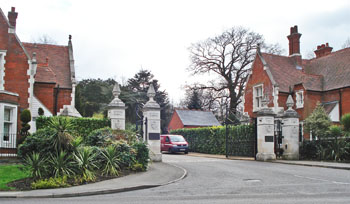
The main entrance with lodges either side, now known as Clarence Gate. The original entrance had a central pillar and gates.
In 1967 a lorry had hit the one of the gates and caused £250 worth of damage. In 1970 another lorry damaged the gates and the central pillar. The pillar was dismantled and the gates removed. The gates lay rusting in the laundry yard for almost 10 years until they were sold to a Dr Galan, who intended to erect them at the entrance to Cromwell House in Huntingdon. But they proved too large and were then auctioned at Sothebys.
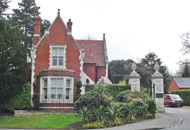

Both lodges have been converted into private residences.
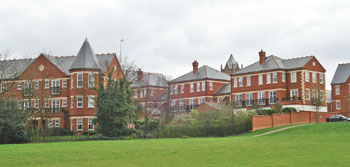
Former ward blocks in red brickwork with plain brick facings.
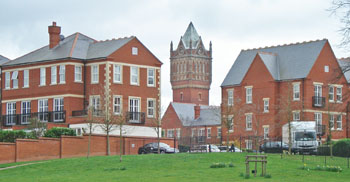
The water tower is seen between two former ward blocks. The 150 ft (46 metres) tall water tower had been struck by lightning on 11th January 1974; the 4 ft (1.2 metre) high weathervane was dislodged and fell to the ground. It was never replaced.
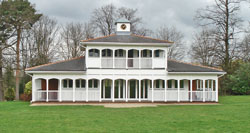
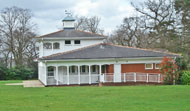
The pavilion in the sports ground.

The central ward blocks from the sports ground
(above and below).

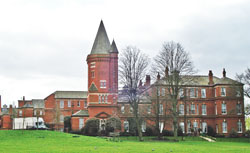
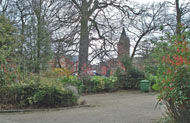
The water tower seen from Clarence Gate.


Glimpses of the former Hospital buildings from Tomswood Road.
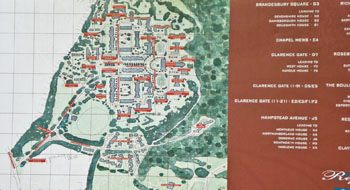
The site map.
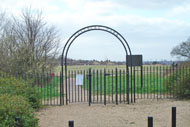
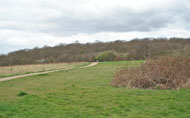
The gate to Claybury Park below the hill (left). The Hospital Hill woods, as seen from the Park (right).
The Asylum Farm (1894-1966)
Initially the Farm was stocked with 80 cows and 400 pigs, which were cared for by hired farm workers helped by 112 patients.
In 1896 30 sheep had been bought at 40 shillings (£2) each. They were kept, not for their meat, but to mow the Hospital's many acres of lawn. Their wool was sold.
At the end of the 1920s the LCC divided hospital farms into administrative groups and, during the 1930s, the Claybury and Friern Hospital farms worked in unison. By October 1939 the Northern Group of farms consisted of Claybury, Friern, St Bernard's and Leavesden Hospitals.
In 1944 the Group was divided and the Claybury farm became part of the Northeastern Group.
The Home Farm consisted of 191 acres but the Hospital leased and operated two other farms - Dunton Farm (89 acres, for pigs, poultry and fruit) and Hutton Hall Farm (413 acres, for cattle, potatoes, corn and fodder).
During the month of February 1949 the Farms produced about 3,755 gallons of milk.
In 1951 some 45 acres were given over to vegetable production, 17 to cattle fodder and 129 to grassland.
In 1952 there were 472 adult chickens in the poultry farm at Home Farm and 400 young ones. At Dunton Farm there were 476 adult birds and 549 chicks. During the year they produced 97,000 eggs and 3.700 lb of poultry meat.
Some 169 pigs were kept at Claybury and 87 at Dunton Farm during 1952 (the stock was increased to 270 in 1955, and to 503 in 1960).
In March 1953 there were 173 cows (68 in milk), producing 4,897 gallons on milk. The herd was reduced after June 1954.
In October 1955 Home Farm had 1,014 adult chickens and 949 chicks, and 19 geese, and 102 adult birds at Dunton Farm. As well as Claybury, the farms supplied Highwood, Cane Hill, Horton and St Faith's Hospitals.
The Hospital farm closed in 1966 following a decision by the Ministry of Health that hospital farms should cease (it was frowned on that patients should be employed to maintain their institution).
Initially the Farm was stocked with 80 cows and 400 pigs, which were cared for by hired farm workers helped by 112 patients.
In 1896 30 sheep had been bought at 40 shillings (£2) each. They were kept, not for their meat, but to mow the Hospital's many acres of lawn. Their wool was sold.
At the end of the 1920s the LCC divided hospital farms into administrative groups and, during the 1930s, the Claybury and Friern Hospital farms worked in unison. By October 1939 the Northern Group of farms consisted of Claybury, Friern, St Bernard's and Leavesden Hospitals.
In 1944 the Group was divided and the Claybury farm became part of the Northeastern Group.
The Home Farm consisted of 191 acres but the Hospital leased and operated two other farms - Dunton Farm (89 acres, for pigs, poultry and fruit) and Hutton Hall Farm (413 acres, for cattle, potatoes, corn and fodder).
During the month of February 1949 the Farms produced about 3,755 gallons of milk.
In 1951 some 45 acres were given over to vegetable production, 17 to cattle fodder and 129 to grassland.
In 1952 there were 472 adult chickens in the poultry farm at Home Farm and 400 young ones. At Dunton Farm there were 476 adult birds and 549 chicks. During the year they produced 97,000 eggs and 3.700 lb of poultry meat.
Some 169 pigs were kept at Claybury and 87 at Dunton Farm during 1952 (the stock was increased to 270 in 1955, and to 503 in 1960).
In March 1953 there were 173 cows (68 in milk), producing 4,897 gallons on milk. The herd was reduced after June 1954.
In October 1955 Home Farm had 1,014 adult chickens and 949 chicks, and 19 geese, and 102 adult birds at Dunton Farm. As well as Claybury, the farms supplied Highwood, Cane Hill, Horton and St Faith's Hospitals.
The Hospital farm closed in 1966 following a decision by the Ministry of Health that hospital farms should cease (it was frowned on that patients should be employed to maintain their institution).
(Author unstated) 1900 The cost of asylums. British Medical Journal 1 (2044), 530.
(Author unstated) 1904 Radium as a mind healer. British Journal of Nursing, 22nd October, 326.
Jones R 1897 The London County Council Asylum at Claybury, and a sketch of its first working year. British Journal of Psychiatry 43, 47-48.
Pryor EH 1996 A Pictorial History of Claybury Hospital. Forest Health Care, Mental Health Care Group.
Robertson WF, McRae D 1907 Further bacteriological and experimental investigations into the pathology of general paralysis and tabes dorsalis. British Journal of Psychiatry 53, 590-615.
(Author unstated) 1909 International Congress of Nurses. British Journal of Nursing, 14th August, 136.
(Author unstated) 1917 Zeppelin fright. British Journal of Nursing, 16th September, 228.
(Author unstated) 1921 The Matrons' Council of Great Britain and Ireland. British Journal of Nursing, 29th October, 274.
(Author unstated) 1929 A visit to Claybury Mental Hospital. British Journal of Nursing (July), 184.
Chaplin R, Peters S 2003 Executives have taken over the asylum: the fate of 71 psychiatric hospitals. Psychiatric Bulletin 27, 227-229.
Jones R 1905 The medical treatment of insanity. British Medical Journal 1 (22nd April), 875-878.
www.countyasylums.com
www.elizabethpride.com
www.redbridge.gov.uk
www.thetimechamber.co.uk
Return to home page